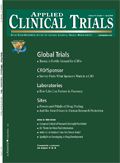Genotyping: Under the Microscope
Applied Clinical Trials
Dr. Steve Dodsworth, director of molecular genetic services for Tepnel Research Products & Services, assesses that with molecular insight comes the opportunity to counter disease development and progression.
Therapeutics are developed to improve health and create wealth. These two factors can work in synergy or in opposition, and the role of genotyping in drug development is not immune to these powerful driving forces. Genotyping is the process by which inter-individual variation at the level of the nucleotide sequence is identified and categorized. If this variation correlates with variation in the biological reaction to a drug candidate, then opportunities to refine the development process arise, including early termination.

Dr. Steve Dodsworth
During the drug development process, insight into the molecular basis of disease and the action of drug candidates is sought. With understanding comes the opportunity to develop strategies and pharmaceutical products to counter disease development and progression.
Drug targets. Typically, drug targets are receptors or transporters. Highly polymorphic targets (arising from variation at the genetic level) are likely to give rise to highly variable drug response, as the interaction between drug and target may be greatly influenced by variation in the target's structure and function. Ultimately, the level of variation may be decisive in whether such a target is a viable option to support further development. Where therapeutics that interact with highly variable targets reach market, efficacy and safety issues may arise, causing complications in dosing.
Drug Metabolizing Enzymes (DMEs). Enzymes involved in drug metabolism (DMEs) break down and clear drugs from the body, and some therapeutics rely on DMEs to provide pharmacologically active metabolites. Poor metabolizers receiving a standard dose may experience adverse reactions through the elevation of the therapeutic substance to toxic levels due to inefficient clearance of the drug from the body. Fast metabolizers may not benefit, as they may clear the substance from the body too quickly. Equally, where metabolites are required for pharmacological activity, variations in metabolism may lead to adverse events or poor efficacy, as the drug is transformed to its metabolites at unexpected rates.
Stratification. Historically, patients showing similar or near identical symptoms have been grouped under one disease heading. It is likely that heterogeneity at the molecular level is present within such groups. As our understanding improves at the molecular level, such populations will be divided and subdivided. The ability to select subjects on the basis of a molecular diagnosis can only provide benefit.
Where genotype, metabolism, and clinical observations demonstrate high levels of correlation, then recruitment for trials may be based on genotype. Although a test to determine genotype would be required for such a therapeutic, the possibility of bringing drugs to market that would otherwise be rejected through efficacy and safety issues is raised.
It appears that genotyping in drug development can only be of benefit, but there are issues to address. From a marketing perspective, would a drug requiring a test before prescription be able to compete with another drug that, although less effective, did not require such an inconvenience? Where the benefit of prescription based on genotype outweighs the cost and inconvenience of prescribing without such knowledge, then the market will develop. Whether companies, customers or the regulatory authorities become the driving force in this development has yet to be revealed.
Dr. Steve Dodsworth Director of Molecular Genetic Services Tepnel Research Products & Services www.tepnel.com
